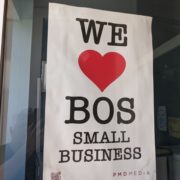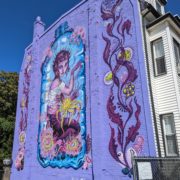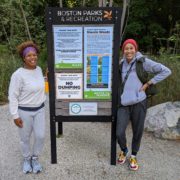#WalkingBoston Advocating for #WalkingCityTrail at Boston City Hall
By: Patrick Maguire
Book Chapter: Human-to-Human Service
Posted: 03/7/2023
There is movement underfoot in Boston and I’m proud to be in the thick of it.
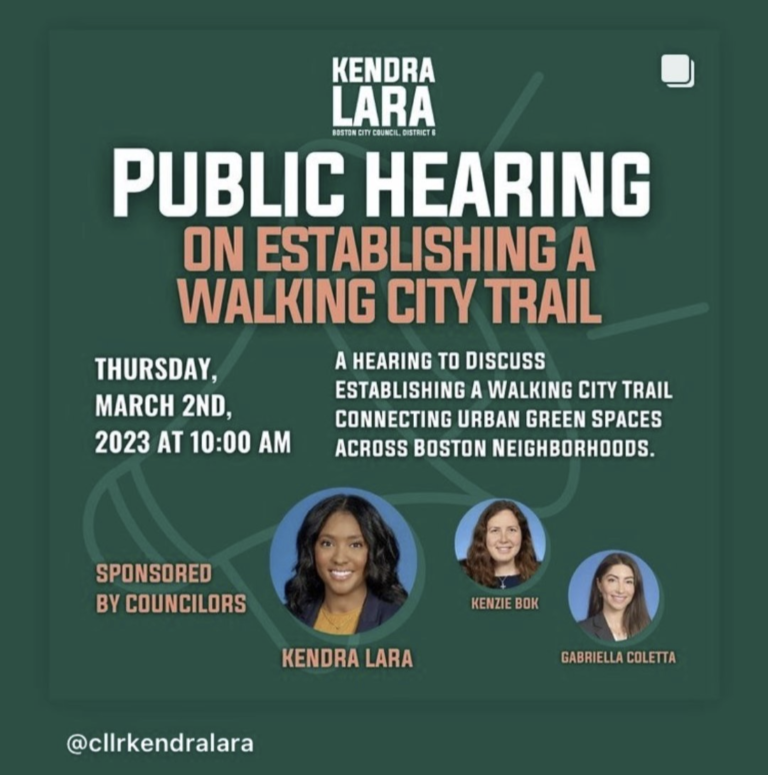
Miles Howard founded and launched Walking City Trail, an urban hiking trail connecting Boston’s parks, urban wilds, gardens, greenways, and residential neighborhoods in June of 2022. On February 8, 2023 Miles wrote, “When the Walking City Trail launched last June, the invitation to Boston residents and visitors was twofold—come hike the trail and share your ideas for how the WCT could be made better. Trails survive and flourish if communities of hikers want them to. And with that outcome in mind, this past summer and fall’s community section hikes along the Walking City Trail brought hundreds of hikers into Boston green spaces, where inspired ideas for trail extensions and reroutes were proposed.”
As a result, the Walking City Trail is now 27 miles and connects 17 Boston neighborhoods. I love the idea of having a community-curated trail mapped out for all of us to explore and discover more of Boston. As noted in my testimony below, I walked portions of 2 sections of Walking City Trail, just for the enjoyment of it, but also as ‘training’ walks for my #WalkingBoston endeavor. I also walked a chilly ‘scouting mission’ with Miles dubbed, ‘Cold AF Boston Harborwalk,’ where we covered 5+ miles, primarily along the water in Charlestown on 12/19/22.
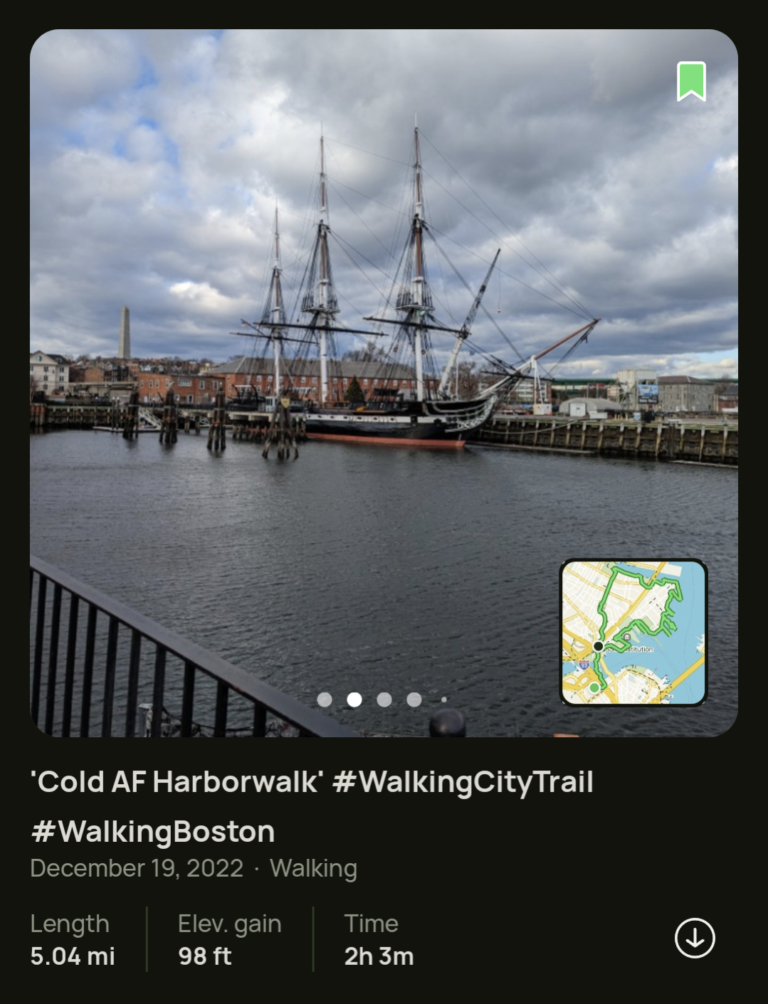
On Thursday, March 2, 2023, Miles Howard and Walking City Trail advocates were invited by the Boston City Council’s Committee on Environmental Justice, Resiliency and Parks to a hearing to ‘Discuss Establishing A Walking City Trail Connecting Urban Green Spaces Across Boston Neighborhoods.’ The matter was sponsored by Councilors Kendra Lara, Kenzie Bok, and Gabriella Coletta. The objectives of the hearing were to begin the conversation about having the City of Boston officially recognize the Walking City Trail, furnish signage along the trail, and possibly create a role within the Parks Department to support the creation of more urban trails in Boston. Miles invited me to participate on a small panel “of people who can speak to the benefits 0f urban hiking/walking and approaching the city as a place of exploration and discovery.” This was a watershed moment for me and #WalkingBoston, and I was thrilled to participate.
Opening Testimony from Miles Howard:
Testimony for Docket #0251, on Urban Trails
Miles Howard, author, journalist, founder of the Walking City Trail:
“Thank you to Councilor Lara, Councilor Bok, and Councilor Coletta for sponsoring this hearing and bringing all of us here to discuss the possibilities of urban trail–making in Boston. Boston has historically been called “America’s Walking City,” and rightfully so. While our sidewalks and public transit network have plenty of room for improvement, our existing resources and our distribution of green space— within a 10 minute walk of every resident—make Boston a lovely place to go for a stroll. The first year of the pandemic dramatically underscored this, with stay-at-home orders forcing us to cobble together our own adventures and getaways with the resources we have right here, in our shared backyard. Long walks across green spaces and neighborhoods have been a vital tonic for many of us who call Boston home.
During those early pandemic days, I read a National Geographic story about something that seemed to lean into this idea of using local resources to create a scenic experience. The Crosstown Trail. This 17-mile hiking route across San Francisco connects some of the city’s must immersive woods, canyons, and coastal cliffs. But it wasn’t just the green spaces along the Crosstown Trail that intrigued me. It was how the trail builders—working at a grassroots level and from within the city—had chosen paths, streets, and public transit stations to create this epic urban trail that can be hiked in pieces, or in one day. Exactly one year ago, on this date, I hiked the Crosstown Trail. I experienced dimensions of San Francisco that I had never heard of before: things that made me eager to return and poke around even more. And as I waited for my red eye flight back home, my mind kept circling back to one question: what would this new model of urban trail making look like in Boston?
Today, only one year later, Boston has the Walking City Trail. Running 27 miles from the Neponset River to Bunker Hill, and accessible via the MBTA, this urban hiking trail was scouted and mapped last spring. Not a single shovel was picked up to create this trail, which mixes pre-existing paths and streets to yield an immersive hiking route. Maps and trail directions, available for free online, show visitors how to walk across nearly 30 green spaces and 17 Boston neighborhoods.
The WCT, as we’ve come to call it, was a proof-of-concept of what *a* cross-city urban trail could look like in Boston. But it was also an invitation to Boston: to help shape the route of the Walking City Trail and imagine *more* urban trails.
Thanks to Councilor Lara and Mothers Out Front, I had the privilege of co-leading several short community hikes along sections of the Walking City Trail last summer. People came to these hikes with terrific ideas for how the trail could be re-routed and changed to include more green spaces and interesting streets: changes that have since been made to the trail. This was the point when the WCT really became more of an ensemble project. But these hikes also brought residents and visitors from many neighborhoods together for a journey that felt like a roaming conversation— which touched on more than just green spaces. As we hiked by public art, local restaurants and shops, and endangered affordable housing, these fixtures of the trail become pillars of our conversation.
Something magical happens when you put people on a trail together, whether they came as a group or crossed paths. And in a city as historically segregated by race and income as Boston, anything that sparks cross-pollination
between our neighborhoods is worth exploring. Urban trails like the Walking City Trail have the potential to not only bring Boston residents and visitors together in public spaces, but to inspire a sense of collective ownership and stewardship of all public spaces in Boston—whether we’re talking leafy parks like Arnold Arboretum or the Edgewater Greenway, or the animated streets of the Leather District, Mattapan, and Mission Hill.
The words I heard most often on those community hikes were, “I had no idea this place existed.” Today, hundreds of Walking City Trail explorers have found the trail online through social media and word-of-mouth. But with physical signage posted along the trail, showing people where they stand on a 27 mile artery of greenery and streets, the Walking City Trail could be enjoyed by so many more residents and visitors.
What we’ve created in less than a year isn’t just a singular trail—it’s a model for urban trail-making that encourages community participation and requires minimal resources. This is not the Big Dig—it’s not even building a new park! It’s a scalable, low-cost tool that Boston can pick up and use. We can do this by creating a new role to support the creation of more urban trails for all abilities…trails that would reach every community. Boston can be a trailblazer amongst cities and create an urban hiking network.
The Freedom Trail has already shown us the draw of urban trails, and building a network of trails like the WCT, shaped by Boston community members, can highlight the connections that exist between our neighborhoods, *and* establish new connections for a more accessible city. Urban trails can be a path to getting more of us involved in the conversations and processes that determine how Boston can equitably distribute resources such as trees, grass, water access, transit stops, pedestrian facilities, and maps of the cityscape.
I’m grateful to be here today with all of you, diving into this conversation about how urban trails can move Boston toward becoming a city where every person can play a role in shaping these decisions. Let’s take this path together and see where it leads us. Thank you.”
Video of Miles Howard Testimony
Follow Miles Howard on Twitter
“Good Morning. My name is Patrick Maguire, an almost lifelong resident of the Boston area. Thank you, Miles Howard, for including me today, and to Councilor Kendra Lara and her colleagues for their initiative and leadership in co-sponsoring today’s hearing. I’m honored to be here.
The Boston Public Garden in full bloom in the Spring is absolutely GORGEOUS. Strolling along the banks of the Charles, the Emerald Necklace, Harborwalk, and the Freedom Trail are invigorating, immersive, and informative.
But there’s SO much more to Boston that we should be proud of, showcase, and make it easy and accessible for residents and visitors alike to discover and enjoy.
Despite living in the Boston area for more than 50 years, I’m embarrassed to say that I don’t know our city nearly as well as I should. So, I decided to do something about it.
On August 16, 2022, I launched an adventure of discovery called, #WalkingBoston – ‘A Marathon in Every Boston Neighborhood.’ Each official walk is a minimum of a half marathon.
To date, I’ve walked more than 121 miles in Eastie, Hyde Park, JP, and most recently, the South End. The distances are verified using the MapMyWalk application and AllTrails, the same app used to map and provide GPS guidance for Walking City Trail.
The #1 stated objective when I launched #WalkingBoston was to explore and show off Boston’s neighborhoods by walking deep into every one of them, discovering hidden gems and the real ‘heart and soul’ of our city.
After each walk, I share pictures and videos in chronological order of the journey. I’ve posted more than nineteen hundred of them from the 4 neighborhoods I’ve covered, and they’re accessible to everyone.
The discovery and experiences so far have been exhilarating and have reinforced the notion that there is so much more to explore right in our own backyard. I’m beginning to appreciate Boston SO much more than I have my entire life. As a result, I believe that we need to do more to showcase the Best of Boston’s #RoadsLessTraveled.
A few highlights from my #WalkingBoston adventures so far:
Exploring the gritty dirt path on the water in Eastie behind Umana Academy with unique, stunning views of the Boston Skyline, Charlestown, the Tobin, and old school marinas and pilings with nautical artifacts strewn about…
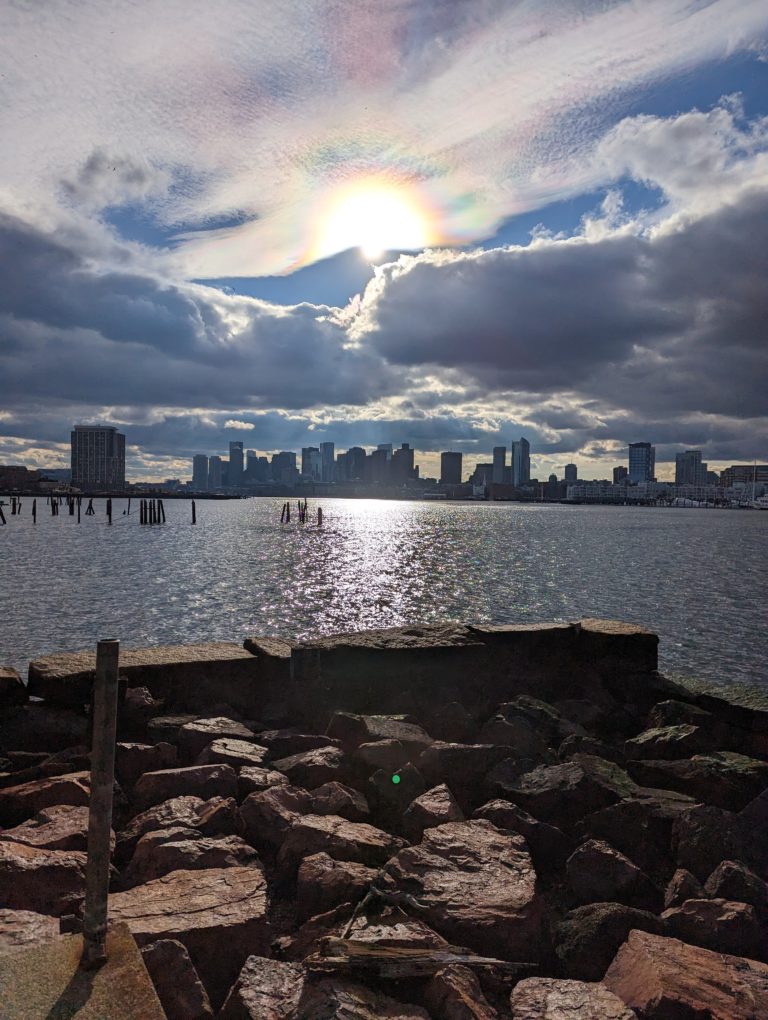
Meeting and chatting with Eastie resident, Barbara who was picking up litter in the shared, public space in her neighborhood…

Talking with crossing guard, Marianne O’Dowd (in yellow below)… [Photo by Matthew MacDonald. From L to R, Maguire, Hyde Park ONS (Office of Neighborhood Services) Liaison, Denyel Fonseca, crossing guard, Marianne O’Dowd and Hyde Park resident, Quiana Agbai.]
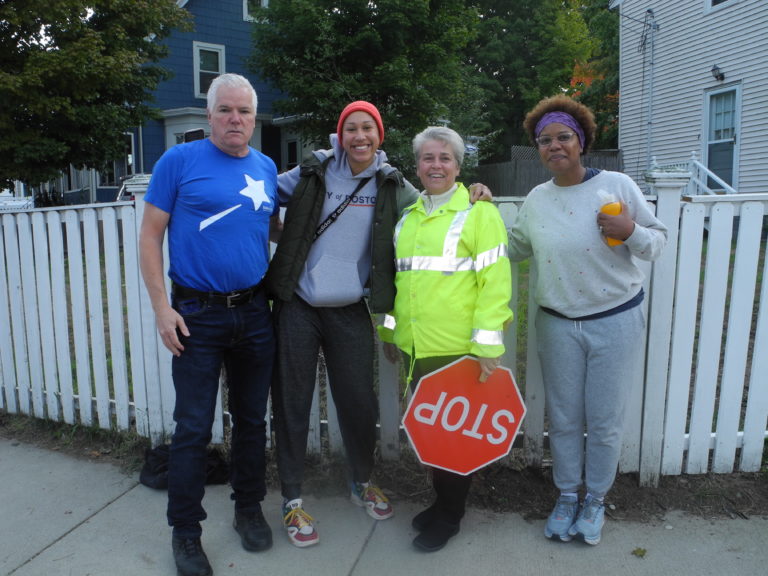
Chatting with painter, Jen Vanora who was touching up a mural on a wall outside of Ron’s Ice Cream in Hyde Park…
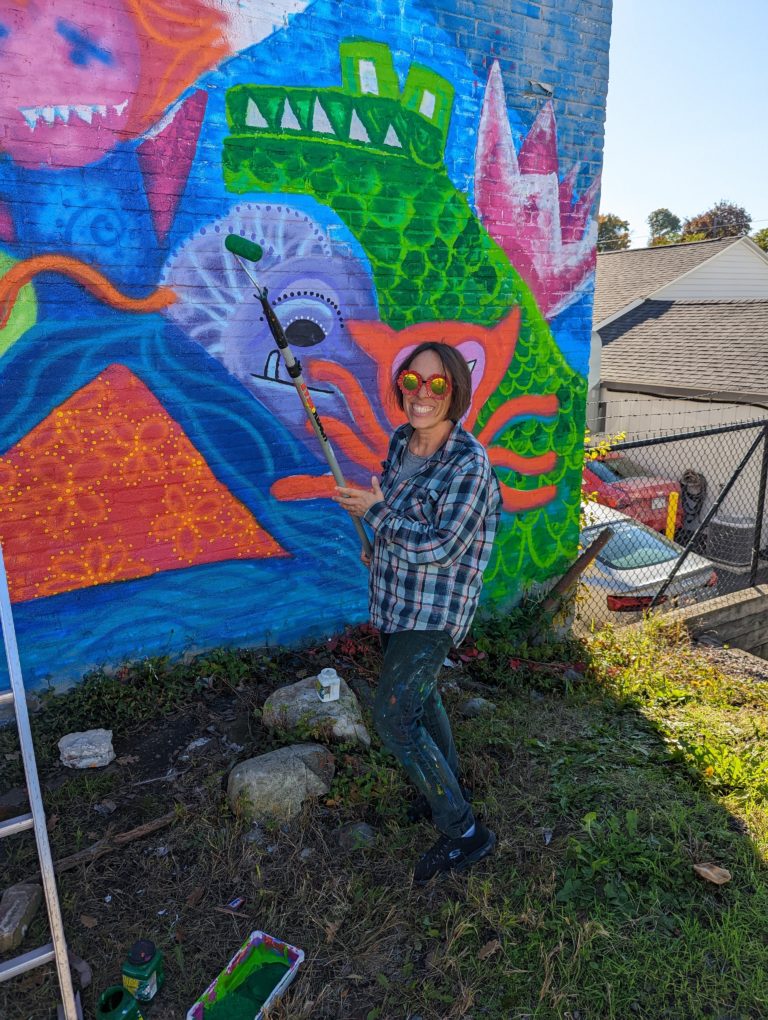
Meeting and walking with Denyel Fonseca, Liaison for the City of Boston and exploring and discovering Hyde Park together…
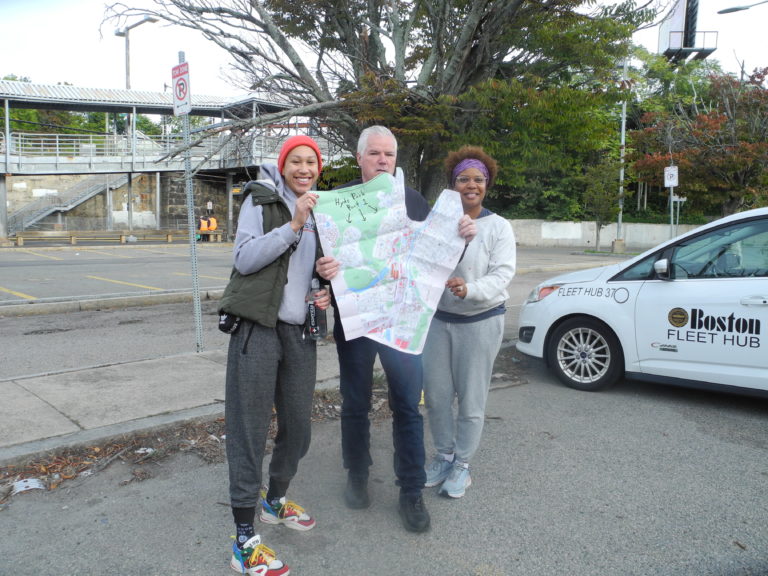
[Maguire with ONS Liaison, Denyel Fonseca (L) and Quiana Agbai (R) at Hyde Park Commuter Station w/map of the walking route. Courtesy of Matt MacDonald The Bulletin.]
Standing in the middle of Forest Hills Cemetery mid-morning, surrounded by gorgeous foliage as the church bells chimed 10 times from Forsyth Chapel, and capturing that moment on video.
Walking 13.48 miles with Hyde Park resident, Matt MacDonald, a reporter for Boston Neighborhood newspaper, The Bulletin. I called that my ‘George Plimpton moment.’ Mr. Plimpton was a ‘participatory journalist’ who immersed himself in roles, including playing goalie with the Boston Bruins in 1977, then wrote about those experiences.
We all know about the variety of physical and emotional benefits to walking. There’s also SO much potential opportunity through the exploration and discovery while walking. Whether it be solace, community, adventure, beauty, inspiration, or enlightenment we’re seeking, the fresh air and perspective can literally change our lives. It absolutely has changed mine.
Walking City Trail encapsulates and enhances everything I have described above. I walked WCT Section 1 through Mattapan, Hyde Park, and Roslindale alone. I loved the experience and the discovery of hidden gems and relics like the original T logo on an old abandoned Orange Line Trolley, and I really appreciated the ease of mapping and navigation with the AllTrails application.

Experiencing Walking City Trail is an invitation to see parts of Boston lots of people don’t even know exist. Imagine someone stating that they “KNOW” Cape Cod without ever having visited the tremendous ocean side outer beaches and cliffs of the National Seashore from Orleans to P-Town??? The curated Walking City Trail guides us to places we NEED TO SEE to truly know Boston, our people, history, and community more fully.
I also joined Miles, Max, Kendra, and a very interesting, informative, fun group of people covering Section 2, Part 1 of Walking City Trail in October that included fascinating parts of the Arboretum, murals, inspiration, and architecture that I had never seen before.
I strongly believe in and support Walking City Trail and this initiative for the City of Boston to recognize and embrace it by providing trail signs to make it more approachable and accessible for everyone. Investing in Walking City Trail and the proposed Urban Trail Role in the Parks Department, are tremendous ways to leverage the EXISTING resources and beauty of our parks, paths, woods, neighborhoods, and roads less traveled.
Miles Howard and volunteer community members have literally ‘walked the walk’ to create essentially a ‘guided tour’ for all of us, and everyone visiting Boston, to experience and enjoy.
Walking City Trail, and future urban paths, will enhance not only Boston’s image, but learning and education, our economy, our communities, and the mental, physical, and social health of our residents. Let’s work together, and walk together to officially codify, support, and promote Boston’s Walking City Trail. I’m grateful for your time, attention, and consideration. Thank you very much.”
Video of Patrick Maguire Testimony
Video of Karen Mauney-Brodek Testimony – President Emerald Necklace Conservancy

[ pictured L to R, Karen Mauney-Brodek and Miles Howard courtesy of Richard Howard.]
Video of Max Hunter Testimony – Mothers Out Front
Bob Siegel Testimony – San Francisco Cross Town Trail
The entire hearing can be viewed by ‘rewinding’ to the beginning of any of the videos above.
Subscribe to the Walking City Trail Newsletter via this link.
Thank you for following, supporting, and sharing the missions of #WalkingBoston & #WalkingCityTrail.
Chinatown and adjacent neighborhoods are next up for #WalkingBoston. Subscribe to this blog for scheduling.
Cheers-Patrick
Photo Credit: The first pic under ‘Server Snapshots’ is courtesy of Richard Howard.
Leave a Reply
Permalink | Posted in Human-to-Human Service | No Comments »

